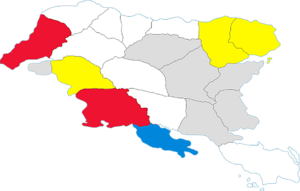Gylian federal election, 1990
| |||||||||||||||||||||||||||||||||||||||||||||||||
All 500 seats in the Chamber of Deputies All 400 seats in the Senate 251 Chamber of Deputies seats and 201 Senate seats needed for a majority | |||||||||||||||||||||||||||||||||||||||||||||||||
|---|---|---|---|---|---|---|---|---|---|---|---|---|---|---|---|---|---|---|---|---|---|---|---|---|---|---|---|---|---|---|---|---|---|---|---|---|---|---|---|---|---|---|---|---|---|---|---|---|---|
| Turnout | 96,1% | ||||||||||||||||||||||||||||||||||||||||||||||||
| |||||||||||||||||||||||||||||||||||||||||||||||||
 | |||||||||||||||||||||||||||||||||||||||||||||||||
| |||||||||||||||||||||||||||||||||||||||||||||||||
Federal elections were held in Gylias on 22 January 1990, to elect the 500 members of the Chamber of Deputies and 400 members of the Senate.
A realigning election after the wretched decade, the Non-inscrits gained a plurality of votes and seats for the first time. Voters punished established blocs for their part in the wretched decade. Mathilde Vieira became Prime Minister, leading a "plural coalition" of liberals and non-inscrits.
Electoral system
Both chambers of the Gylian Parliament were elected through single transferable vote, using the Droop quota.
The Chamber of Deputies was elected using 5-member circonscriptions, drawn by Elections Gylias based on regional populations.
The Senate was elected by regions, each electing 20 senators.
Parties were not allowed to nominate more than one candidate per seat. Candidates were not allowed to run for both chambers simultaneously.
Parties
| Electoral bloc | Parties | Political position | |
|---|---|---|---|
| Progressive Alliance (PA) |
DCP, SP, SDP, DL, LSL | Left-wing | |
| Liberal Union (LU) |
NUP, NLP, PRRA, LLR, FSP | Centre-left | |
| Centre Group (CG) |
MCP, RDC, RCP, IPR, CCM | Centre | |
| National Bloc (NB) |
CNP, NPR, PDU, UND, MRR | Centre-right | |
| Union for Freedom and Prosperity (UFP) |
PP, IFP, PFG, FEP, ECM | Right-wing | |
| Revolutionary Rally (RR) |
RWP, WLF, PRV, RCR, RMP | Far-left | |
| Front for Renewal of Order and Society (FROS) |
ACFF, PNM, RNM, PND, RU | Far-right | |
| Non-inscrits (NI) |
APP, ARENA, FLP, FVU, GP, HP, IRAM, LND, LSDP, NAF, NPP, PP-CM, RFS, RJU, UI, UM, UNR | Various | |
Background
While the wretched decade ended after the Ossorian war crisis of 1986, the Filomena Pinheiro government spent the rest of the decade undoing the damage caused. As an interim Prime Minister, Filomena had no mandate to implement major changes. These became the main topic of the coming election.
Various political realignments happened before the election. Filomena's crackdown on the RR and FROS removed them from Parliament. The dérive au droite and exposure of the neoliberal conspiracy caused a great scandal that similarly destroyed right-wing populist parties.
Established blocs suffered a backlash for their failures in the wretched decade. The National Bloc suffered a split after Lea Kersed's death. Two of its parties split to form the Union for Freedom and Prosperity. Although the NB acted swiftly to reorganise itself, the split and loss of Lea hobbled them into the campaign.
Opinion polls since 1985 showed the Non-inscrits gaining at other blocs' expense. Lea's death caused the NB to lose its standing as well. Newly-established parties like the New Alliance for the Future and Love, Nature, Democracy benefited the most. The establishment of the Minor Party Alliance also heightened anticipation. It sought to fix the non-inscrits' weakness in previous elections: too many parties and inefficient preference distributions.
Campaign
The election had a festive atmosphere, with much relief that the wretched decade ended. The Progressive Alliance used the slogan "restore eupraxia". The Liberal Union adopted the slogan/unofficial theme song "Chega de Saudade", partly in reference to half-Lusitan foresitter Mathilde Vieira. The NAF promised to "build a bridge to the 21st century".
The campaign saw a new crop of charismatic, media-savvy foresitters. Mathilde Vieira's youth and anti-Aén credentials proved a boon for the LU. Governor of Nauras Édith Champion ended the PA's long period of disarray and collective leadership. Mielikki Salonen's campaign was described by Ŋéida Vaşad as "seemingly impervious to embarrassment". She took advantage of caricatures depicting her as a soundbite-spouting technophile.
One of the stars of the election was Moana Pozzi, a famous pornographic actress and LND foresitter. Moana playfully inserted her presence in the campaign, delivering innuendo-laced speeches and wearing physique-enhancing Kaede Nakano business suits. She famously used the slogan "If you want to waste your vote, vote for us!", explicitly seeking support from disillusioned and apathetic voters. She starred in a celebrated PPB, satirically discussing sex as if it was the economy and criticising politicians for ignoring the "sex recession".
The UFP became the marginal figures of the election. Their right-wing profile and explicit advocacy of capitalism was met with hostility. Their candidates were frequently heckled and booed out of public meetings. They gained a reputation as "petty and joyless sociopaths" for supporting privatisation of beloved institutions like Gyliair and GNRTS. In one incident, they reported LND's PPB to the Information Bureau for misinformation. The IB instead replied that the PPB was clearly a satirical short film, earning the UFP a flood of mockery.
Results
In accordance with electoral law, the results were embargoed until the full counting and transfers were completed, and were released all at once on 26 January.
| Parties and blocs | Chamber of Deputies | Senate | |||||||||
|---|---|---|---|---|---|---|---|---|---|---|---|
| FPV | % | ± | Seats | ± | FPV | % | ± | Seats | ± | ||
| Non-inscrits and independents | 2.510.200 | 25,5% | 255 | 3.464.711 | 35,2% | 171 | |||||
| Liberal Union | 1.988.472 | 20,2% | 64 | 1.653.612 | 16,8% | 61 | |||||
| Progressive Alliance | 1.850.657 | 18,8% | 63 | 1.624.083 | 16,5% | 60 | |||||
| National Bloc | 1.771.906 | 18,0% | 60 | 1.594.554 | 16,2% | 55 | |||||
| Centre Group | 1.378.149 | 14,0% | 55 | 1.210.680 | 12,3% | 50 | |||||
| Union for Freedom and Prosperity | 196.878 | 2,0% | New | 3 | New | 187.016 | 1,9% | New | 3 | New | |
| Revolutionary Rally | 127.971 | 1,3% | 0 | 78.743 | 0,8% | 0 | |||||
| Front for Renewal of Order and Society | 19.688 | 0,2% | 0 | 29.529 | 0,3% | 0 | |||||
| Total | 9.843.921 | 100% | — | 500 | — | 9.842.928 | 100% | — | 400 | — | |
| Registered voters and turnout | 10.331.230 | 96,1% | |||||||||
Analysis
The non-inscrits won a plurality of first preference votes for the first time. Having secured Chamber of Deputies pluralities since 1976, they now won a collective majority of 255 seats. The Minor Party Alliance proved effective, and the biggest winner among non-inscrits was the New Alliance for the Future, which finished third overall. Similarly strong gains went to Love, Nature, Democracy, the Green Party, and People Power-Citizens' Movement.
Voters punished the established blocs for their failures in the wretched decade. After their promising breakthrough in 1985, the NB lost 6% of first preference votes and 40 Chamber of Deputies seats. The CG largely stagnated. Mathilde Vieira led the LU to second place overall, but its 8,1% gain in first preference votes brought only 9 more deputies. This made liberals larger than the left for the first time since the Popular Progressive Front. The PA avoided worse losses, with Édith Champion credited for her vigorous campaigning.
The UFP won 2% of first preference votes and 3 seats in each chamber, a result that brought more mockery upon them. Unsurprisingly, the RR and FROS were shut out of parliament after Filomena's crackdown.
The non-inscrits' breakthrough scrambled the regional map. 8 regions returned ties, and 6 regions non-inscrit pluralities. The PA fell behind non-inscrits in their traditional strongholds of Mişeyáke, and managed a tie in the northern regions. It only carried Tomes and Tandar. For the first time, the NB failed to carry Nerveiík-Iárus-Daláyk, which was tied instead. Their only plurality was in Nauras.
Aftermath
The new Parliament was sworn in on 1 February 1990, once again with no obvious government to be formed. The non-inscrits' collective majority made it clear they'd have a significant role in government formation.
Mathilde Vieira got the first mandate to form a government, as the LU had more seats in total than any other party. She first sought to rebuild the PA–LU–IRAM alliance of the Golden Revolution. However, the negotiations with the PA were unsuccessful. She settled on accepting their confidence and supply from outside the government. Talks to include the NAF and LND progressed smoothly. She also reached out to the NB out of respect for their role in Filomena's grand coalition.
The final proposal presented to Parliament was unexpected. Mathilde proposed a LU–NAF–LND–IRAM minority cabinet, which would include a few ministers from the PA and NB without their full participation. Her shrewd negotiation paid off, and the cabinet was approved.
While a seemingly weak foundation for a government, Mathilde made it work with her talent for parliamentary negotiation and dealmaking. Her "plural coalition" inaugurated the "liquid Parliament" era, in which the other blocs took an ambiguous role, blurring the line between government and opposition.




